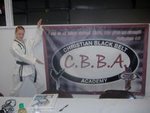PLEASE KNOW THAT POTATOES ARE A LOW ACID FOOD AND CANNOT, I REPEAT CANNOT BE CANNED/ PROCESSED IN A WATER BATH CANNER. LOW ACID FOODS REQUIRE A HIGHER TEMPERATURE TO PROCESS SAFELY AND ONLY A PRESSURE CANNER CAN ACCOMPLISH THIS. PLEASE FOLLOW DIRECTIONS ON YOUR PRESSURE CANNER AND CONSULT WITH THE BALL BLUE BOOK CANNING GUIDE PRIOR TO ATTEMPTING TO CAN POTATOES.
I also added information about water level in the potatoes at the end of this post.

The potato mash seen here is made using 1 1/2 quart of canned potatoes a bit of plain soymilk (1/3 cup) and a tad of nutritional yeast (1/2 Tbsp). Straight from the jar, drained, and placed into a bowl, I mashed them by hand with a potato masher and then made VWAV punk rock chickpea gravy to top. I liked the gravy even though some of the spice mixture (like every spice in the cupboard) made me wonder what I was attempting to accomplish. I went to the ppk kitchen site to see if I could find a recipe similar, but no avail... this one must be a treasure for the book. Here is a link to
ppk general gravy recipes posted on that site. My picture features the potatoes with a side of home canned corn and stuffed mushrooms made using whole grain bread crumbs from my freezer. I make bread crumbs with the last of a loaf OR when I have a loaf not turn out so well.... these breadcrumbs happened to come from a loaf that I forgot to add the salt to. The corn was cut off the cob and canned with some dried red bell peppers for flavor.
ABOUT CANNED POTATOES
Someone mentioned that my pictures are small. I usually turn them into thumbnails before uploading them or it takes 3 minutes or more to upload one picture, but as a thumbnail it uploads almost instantly and I do have DSL connection. On my full size home PC the pictures appear big on the screen, but on my laptop they appear small. I plan on taking a closeup of each of the canned goods I use and post it on this blog to show detail in the product when I begin to use it. Today's post will focus in on the potatoes. This is the first year I have canned potatoes because they are a low acid food and I didn't have the ability pre-pressure canner. (See below for information on cold storage.)
My canning friend told me awhile ago her family likes yukon gold potatoes the best as a canned good in comparison to other varieties of potatoes. The few yukon gold potatoes we had this year were eaten early so I had none to can, only a generic russet and pontiac red. I know these have a firmer texture and pleasant yellow color. I was a little concerned that the choices I made might end up mushy after the processing and maybe only good for mashed potatoes, especially the more tender and thin skinned red

potatoes - not so. Now that I have used both varieties I can not that neither are mushy, the only big difference is in the skin. I left the skin on both, the russets skin is tougher but skips right off with a slight rub of the fingers, I did leave the skin in when I made mashed potatoes but I paid special attention to ensuring that they were well blended. Yukon skin is also thin and could be left on for canning purposes.
While comparing these jars visually (these were canned in July and it is now February) the jarred red potatoes look somewhat cloudy, but I can see the defined line of starch as well as the clear liquid separately. I believe this is just a little starch release and the red obviously has more but then potatoes also have various cooking properties. When I opened the jar and drained the liquid the starchy cloud disappeared, the potatoes felt normal, the liquid was not thick, it really was no problem .... just a visual difference between the two. After draining I dumped the potatoes into a bowl and began mashing with a hand held potato masher. They broke apart into what reminded me of a cubed hashbrown and I think could have easily been used for that. In canning I let the skins on these and the skin is thin enough that it causes no problem leaving it on while cooking.
ABOUT COLD STORAGE
Previously we kept potatoes in a cheap food cooler with a blanket wrapped around them at
the bakehouse because we don't heat the bakehouse in the winter (except a special heat tape for the water pipes) so things might freeze there esp when we have temperatures like we have been having (-15 degrees F). The blanket and cooler did protect them through our winter months however this is the coldedt I have seen us since we started gardening and preserving five years ago. I have made it through March with fresh potatoes, carrots, cabbage, and even longer with squash. However by March the potatoes will be growing roots (which I will break off if I am going to cook them), so I use those to plant again. April is the time (Good Friday) to plant potatoes in my village along with some spring greens and a few onions.

In addition to the potato mash I also used 1/2 of the russets to make this simple creation for breakfast. I started by sauteing yellow onion slices and a little minced garlic. I had about 1/4 C chopped red pepper left in a baggie in the freezer so I threw that in. I sliced half a quart jar (after the liquid was drained) of the russet potatoes, saute'd a few minutes more and then added some thawed chopped spinach (a handful ran it under warm water in a small colander). Last I sprinkled with some organic bac-un bits. It was pretty good and I didn't need to kill it with ketchup to give it flavor. It didn't need salt because the water in the jar has a little salt in it and the bac'un bits were salty too.

Here's the label on the bac'un bits I bought. They are vegan and organic. I have tried very red colored vegan bac'un bits before and never cared for them because they reminded me of salt and grease, but these are not to bad.... a flavor of it's own. They are also a natural colored brown.
OTHER THINGS CANNED POTATOES ARE GOOD FOR...
1) open, drain and add them to any stew, Indian food recipe, soup, or other stir fry. They are already cooked and can be used for "fast food".
P.S. I recently had a conversation with someone who asked if I was from the "hippe" generation. Well, no patchouli smells or psychedelic flower symbols here BTW. I grew up in the eighties and although it was "small town no where" I was influenced by the punk movement. I was a heavy metal fan and owned a pair of parachute pants.
From the comments section I had a question asked that I answered there, but then decided I wanted to add it to this main post also.
- Dori, I am curious about the air in the potato jars. I thought that all the food was supposed to be under water?
- Good question erica. I called the Iowa State Extension experts and asked them the same thing when I first saw the water level (which was not this low when I started)... meaning I had the potatoes covered and 1/2 inch from the top before they went into the pressure canner. After canning at 10 lbs pressure for the required 45 minutes (time set by the ball canning guide) for a quart jar the water level lowered below the potatoes. The extension office said that this was normal, the vegetables soak them in when cooking and some of it comes out in steam during the pressure cooking process. The important thing is that the temperature is high enough to kill the botulism bacteria, ONLY a pressure canner that is working correctly and at the right pressure setting as well as the correct time can accomplish that task. Once this happens the water level below the potato is acceptable, however it may be a bit drier.... I didn't not find any difference between the tators at the top and the ones at the bottom. Pressure cookers can be checked at a county extension office.
- I would definitely recommend getting the canning guide (see lnk on my sidebar) prior to attempting LOW ACID canning. It has great pictures of the process and explains everything is great detail.
I think this weekend I will be making up some pasta sauce in my slow cooker using frozen tomatoes from my freezer. I freeze my tomatoes whole in a can flat box, then stick them in a grocery sack until I am ready to use them. Using the harvest part 3 will tell you more - stay tuned. I loved the comments. I know that the site reader tells me what number of visits I get a day, but I never know who is really interested in what I am saying and one sided conversation can get boring.... so thanks.
































